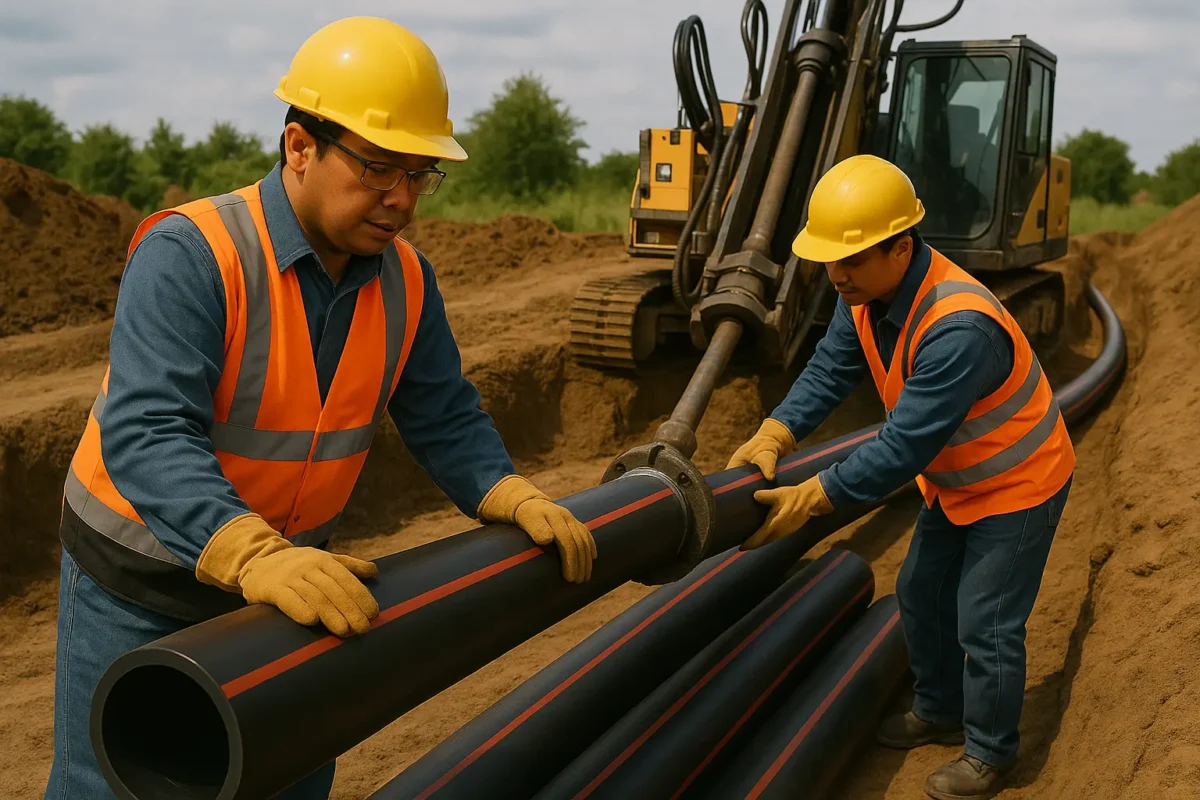Revolutionizing Infrastructure with HDPE Pipe
In today’s world of modern infrastructure, efficiency, durability, and minimal disruption are critical goals for construction projects. Whether it’s water distribution, gas transmission, or telecommunications, project managers and engineers are constantly seeking innovative solutions. One powerful combination leading the way is the use of HDPE pipe, trenchless installation methods, and directional drilling. Together, these technologies are transforming the way pipelines and conduits are installed across cities, towns, and remote areas.
What is HDPE Pipe?
HDPE (High-Density Polyethylene) pipe is a versatile piping material made from strong, flexible thermoplastic. Known for its durability, chemical resistance, and long lifespan, HDPE pipe has become a preferred choice for a wide range of applications, including potable water systems, sewer lines, natural gas distribution, and industrial piping.
One of the key reasons HDPE pipe is so highly valued is its flexibility. Unlike rigid piping materials like steel or concrete, HDPE can bend to accommodate changes in terrain without the need for multiple joints or fittings. This property makes it especially suitable for trenchless installation methods and environments where ground movement or seismic activity is a concern.
Additionally, HDPE pipe is fused together through heat fusion, creating joints that are as strong as or stronger than the pipe itself. This process eliminates the risk of leaks that often plague traditional piping systems.
Trenchless Technology: A Game-Changer
Trenchless technology refers to methods of installing or rehabilitating underground pipes and cables with minimal surface disruption. Traditional pipeline installation typically involves extensive digging, leading to traffic congestion, landscape damage, and high restoration costs. Trenchless methods, by contrast, allow projects to be completed faster, more efficiently, and with much less impact on the environment and communities.
Techniques under the trenchless umbrella include pipe bursting, slip lining, microtunneling, and, most notably, directional drilling. Each method has its unique advantages, but all share the common goal of reducing the amount of open trench required for installation.
Because HDPE pipe is so flexible, lightweight, and durable, it’s an ideal match for trenchless applications. Its ability to withstand the forces of pulling and bending during installation makes it a superior choice compared to more brittle materials.
Understanding Directional Drilling
Directional drilling, also known as Horizontal Directional Drilling (HDD), is a specialized trenchless method used for installing pipes, conduits, and cables underground without the need for traditional trench digging. It is particularly useful for crossing obstacles such as rivers, highways, and railways.
The process involves three main stages:
Pilot Hole Drilling: A small diameter hole is drilled along a pre-determined path using a guided drill head.
Hole Enlargement (Reaming): The pilot hole is gradually enlarged to accommodate the diameter of the pipe.
Pipe Installation: The HDPE pipe is then pulled back through the enlarged hole to complete the installation.
The combination of HDPE pipe and directional drilling is incredibly powerful. The flexibility of HDPE allows it to follow the curved bore path created during drilling without damage. Additionally, its corrosion resistance ensures a long service life, even in challenging soil conditions.
Benefits of Combining HDPE Pipe, Trenchless Technology, and Directional Drilling
When HDPE pipe, trenchless methods, and directional drilling are combined, the results are outstanding. Here are some of the major benefits:
1. Minimal Surface Disruption
Using trenchless directional drilling means there’s no need to dig up roads, landscapes, or environmentally sensitive areas. This approach minimizes the impact on traffic, businesses, and local ecosystems.
2. Cost Savings
While the upfront costs for trenchless projects can be slightly higher, the overall project costs are often lower due to reduced restoration work, faster project timelines, and minimized social disruption.
3. Faster Installation
Directional drilling allows for quicker installation compared to traditional open-cut methods. Projects that might take weeks can sometimes be completed in just a few days.
4. Enhanced Durability
HDPE pipe offers an extremely long service life — often over 50 years — with minimal maintenance. Its fused joints eliminate weak points, making it leak-proof and highly reliable.
5. Environmentally Friendly
Trenchless techniques significantly reduce the amount of soil disturbance and prevent contamination of nearby water sources. Additionally, HDPE’s chemical resistance ensures that it won’t leach harmful substances into the environment.
Key Applications
The use of HDPE pipe with trenchless directional drilling is prominent in various industries:
Water and Wastewater Systems: Ideal for urban areas where digging trenches would disrupt daily life.
Gas and Oil Pipelines: Safely installed under rivers, highways, and protected lands.
Telecommunications and Electrical Conduits: Perfect for rapidly expanding fiber optic networks with minimal impact.
Conclusion
As cities continue to grow and infrastructure demands become more complex, innovative solutions are essential. The combination of HDPE pipe, trenchless technology, and directional drilling offers a highly efficient, cost-effective, and environmentally responsible way to install underground pipelines and conduits. By embracing these advanced methods, project managers, engineers, and municipalities can build resilient infrastructure that stands the test of time, all while minimizing the impact on communities and the environment.
If you are planning your next underground project, consider the unbeatable advantages of HDPE pipe and trenchless directional drilling — a partnership that promises to reshape the future of infrastructure.

